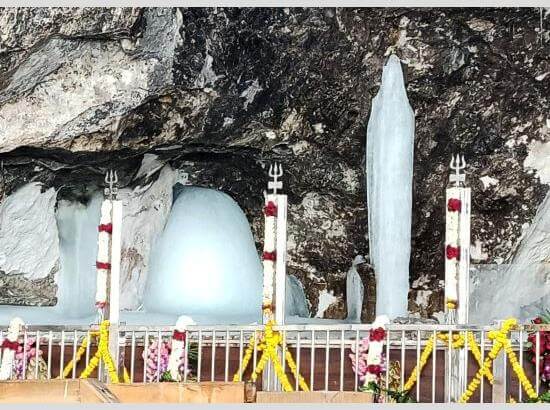Across 28,000 pilgrims from all across the nation came to the sacred Amarnath cave shrine during the first two days of the pilgrimage, which began on Saturday at the twin roads of Baltal and Nunwan-Pahalgam.
28,534 pilgrims have darshan at the cave shrine, according to an official who spoke with Kashmir News Observer (KNO). Meanwhile, 6,461 more pilgrims departed the Bhagwati Nagar Yatri Niwas base camp in Jammu to complete the trip.
He stated that strict security measures have been implemented to ensure the yatra runs well.
Numerous paramilitary groups, the Central Reserve Police Force, the Indo-Tibetan Border Police, and the police have stationed thousands of security officers along the route. Additionally, aerial surveillance is being done.
Reports state that there is a huge rush of pilgrims at twin base camps of Nunwan and Baltal. Thousands of yatris have reached the base camps from different parts of the country for the pilgrimage.
Meanwhile, a fresh batch of 6,461 yatris left the Bhagwati Nagar base camp in Jammu in the wee hours today. These included 4831 men, 1223 women, 14 children, 332 sadhus and 61 sadhvies (female sadhus).
Of these, 2,321 pilgrims left for Baltal at 4:10 am and 4,140 started their journey an hour later for Pahalgam base camp. All these pilgrims have reached their respective base camps by this evening wherefrom they will leave towards the holy cave early tomorrow morning.
Yatris do the Yatra via either the shorter 14 km Baltal-cave shrine route or the more conventional 48 km Pahalgam-cave shrine route. While those who take the Baltal route return to the base camp the same day after receiving “darshan,” those who take the Pahalgam route need four days to reach the cave shrine.
An ice stalagmite formation that waxes and wanes with the phases of the moon is housed in the cave shrine, which is located 3888 meters above sea level. The ice stalagmite structure is seen by devotees as a sign of Lord Shiva’s legendary abilities. This year, several security measures have been put in place at the two base camps, the cave shrine, the twin Yatra routes, and the roughly 300 km long Jammu-Srinagar highway to ensure a smooth, incident-free Yatra.
More than 124 “langars,” or communal kitchens, have been established at the cave shrine, the transit camps, and both of the routes. During this year’s Yatra, more than 7,000 “Sevadars,” or volunteers, are helping the pilgrims. Beginning on July 3, the Railways have planned to add more trains in order to handle the Yatri rush. On both routes, Yatris can also access helicopter services.






 Finance
Finance






